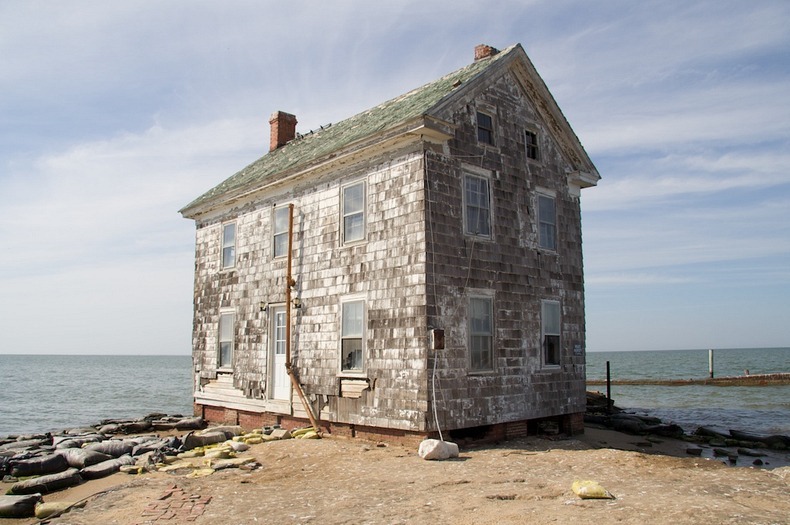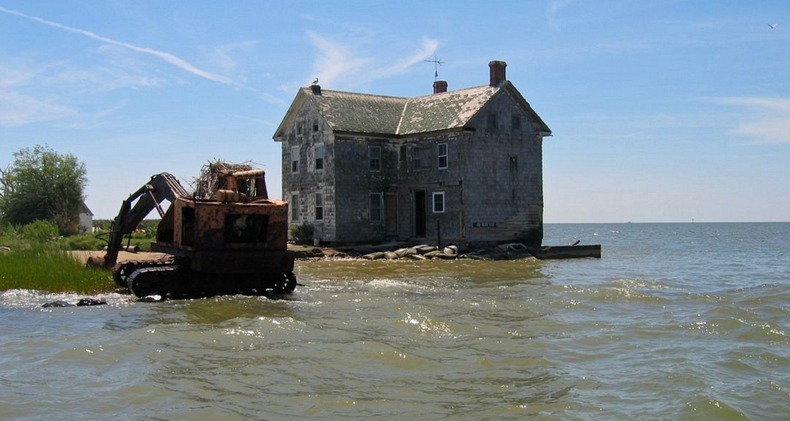The Last House on Holland Island
Holland Island is located in the Chesapeake Bay in Holland
Strait, between Bloodsworth Island and Smith Island, six miles west of
Wenona, Maryland. The island was once about five miles long and one and a
half miles wide, and inhabited by watermen and farmers in a thriving
fishing community. But over the decades, rising Bay waters and natural
sinking of the land ate away at the island until it was nothing but a
blotch of land in the sea. The last house on Holland Island stood
defiantly for over century until its collapse in October 2010. Holland
Island was originally settled in the 1600s, taking its name from the
first owner of the property Daniel Holland. By 1850, the first community
of fishing and farming families developed on the island. By 1910, the
island had about 360 residents, making it one of the largest inhabited
islands in the Chesapeake Bay. At its peak, the island had 70 homes,
several stores, a post office, two-room school with two teachers, a
church, and a community center. It had its own baseball team and a
doctor. The islanders supported themselves mainly by dredging for
oysters, fishing for shad and crabbing. Their fleet of workboats
included 41 skipjacks, 10 schooners and 36 bugeyes, some of which were
built on the island.

The last house on Holland Island in October 2009.
By 1920 the erosion from wind and tide was taking its toll on the island's bay side. Like other Chesapeake Bay islands, Holland Island is primarily made up of clay and silt, not rock, making it prone to erosion. The islanders tried to import stones to build walls along the shore and even sank some old boats to slow the erosion, but lacking modern equipment and techniques, their efforts failed. Most of the residents of Holland Island were forced to leave, and many others disassembled their houses and other structures and took them to the mainland. In August 1918, a tropical storm hit the Bay, nearly destroying the church and prompting the last families to leave by 1922. More and more houses started disappearing under the water, until all but one remained.
Holland Island sat abandoned and neglected until 1995 when Stephen White, a Methodist minister and former waterman who grew up on the island, purchased the house for $70,000 and tried to preserve its legacy by creating the Holland Island Preservation Foundation. Over the next 15 years, Mr White spent nearly $150,000 in his efforts to save the island by building up the shoreline with sand bags, timber, even an old barge.
Stephen White’s valiant efforts went in vain. In mid-October of 2010, the house finally succumbed to the elements and collapsed in a heap. Over the next several months the water took away the wreckage, piece by piece until a year later the rising waters had almost completely engulfed Holland Island.

Holland Island on October 18, 1953













Sources: Sometimes-Interesting, Wikipedia, The Bay Daily, SaveHollandIsland, Imgur Gallery

The last house on Holland Island in October 2009.
By 1920 the erosion from wind and tide was taking its toll on the island's bay side. Like other Chesapeake Bay islands, Holland Island is primarily made up of clay and silt, not rock, making it prone to erosion. The islanders tried to import stones to build walls along the shore and even sank some old boats to slow the erosion, but lacking modern equipment and techniques, their efforts failed. Most of the residents of Holland Island were forced to leave, and many others disassembled their houses and other structures and took them to the mainland. In August 1918, a tropical storm hit the Bay, nearly destroying the church and prompting the last families to leave by 1922. More and more houses started disappearing under the water, until all but one remained.
Holland Island sat abandoned and neglected until 1995 when Stephen White, a Methodist minister and former waterman who grew up on the island, purchased the house for $70,000 and tried to preserve its legacy by creating the Holland Island Preservation Foundation. Over the next 15 years, Mr White spent nearly $150,000 in his efforts to save the island by building up the shoreline with sand bags, timber, even an old barge.
Stephen White’s valiant efforts went in vain. In mid-October of 2010, the house finally succumbed to the elements and collapsed in a heap. Over the next several months the water took away the wreckage, piece by piece until a year later the rising waters had almost completely engulfed Holland Island.

Holland Island on October 18, 1953













Sources: Sometimes-Interesting, Wikipedia, The Bay Daily, SaveHollandIsland, Imgur Gallery